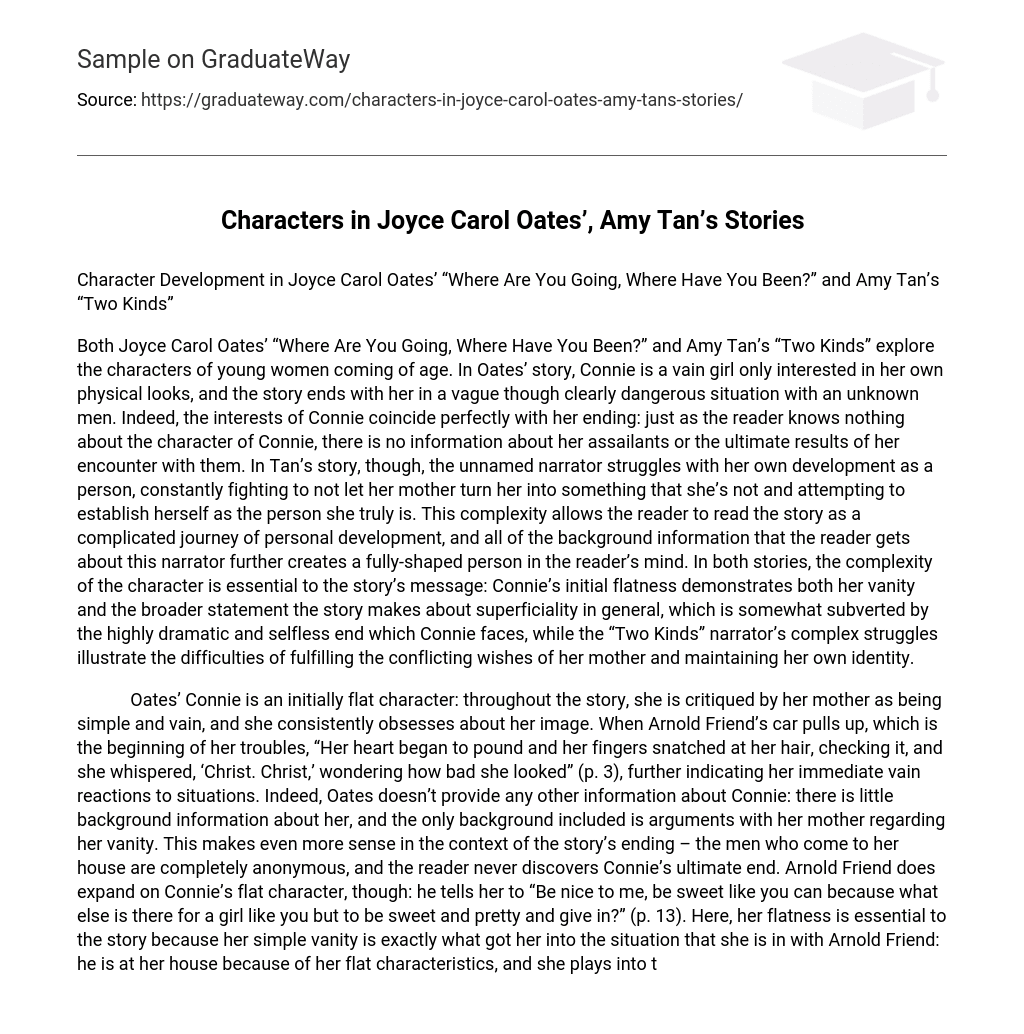Character development is a crucial aspect of storytelling, and it is exemplified in Joyce Carol Oates’ “Where Are You Going, Where Have You Been?” and Amy Tan’s “Two Kinds.”
Both Joyce Carol Oates’ “Where Are You Going, Where Have You Been?” and Amy Tan’s “Two Kinds” explore the characters of young women coming of age. In Oates’ story, Connie is a vain girl who is only interested in her physical appearance. The story ends with her in a dangerous situation with an unknown man. The reader knows nothing about Connie’s assailants or the ultimate outcome of her encounter with them. This lack of information about both Connie and her assailants coincides perfectly with Connie’s interests, making for a mysterious ending.
In contrast, Tan’s story features an unnamed narrator who struggles to develop as a person while fighting against her mother’s attempts to mold her into something she is not. This complexity allows the reader to follow the narrator on a complicated journey of personal development. All the background information provided about this narrator creates a fully-formed character in the reader’s mind.
Both stories illustrate how essential it is for their characters to be complex in order to convey their message effectively. In Where Are You Going, Where Have You Been?” Connie’s initial flatness demonstrates both her vanity and superficiality while subverting these traits with highly dramatic and selfless actions at the end that she faces alone without any help from anyone else.
“Two Kinds” shows how difficult it can be for someone like the unnamed narrator to fulfill conflicting wishes from others while maintaining their own identity which illustrates how important it is for people to stay true themselves even when faced with pressure from others.
Oates’ portrayal of Connie initially presents her as a flat character. Throughout the story, her mother criticizes her for being simple and vain, and she consistently obsesses over her appearance. When Arnold Friend’s car pulls up, signaling the beginning of her troubles, Connie’s immediate reaction is to check herself in the mirror and whisper “Christ. Christ,” indicating her vanity (p. 3).
There is little background information provided about Connie aside from arguments with her mother regarding her vanity. This lack of depth makes sense in light of the story’s ending – the men who come to Connie’s house are anonymous, and the reader never learns what ultimately happens to Connie.
Arnold Friend does provide some insight into Connie’s character when he tells her “Be nice to me, be sweet like you can because what else is there for a girl like you but to be sweet and pretty and give in?” (p. 13). Her flatness is essential to the story because it was precisely this simple vanity that led Arnold Friend to seek out Connie.
However, at the end of the story, when faced with danger, we see a change in Connie’s character as she becomes selfless for the sake of protecting her family. If she had been more rounded from the start, this situation may not have occurred at all.
The narrator of Amy Tan’s “Two Kinds” is much more complicated than Connie. The story traces her mother’s journey from China to the United States of America and provides intensely personal information about the deaths of her children and her struggle for the “American Dream.” Indeed, this is exactly where the narrator comes in: she is a part of her mother’s quest for a better life, and therefore, her mother attempts to make her into a child prodigy.
The entire time this is going on, though, the narrator resists. She states, “I won’t let her change me; I promised myself I won’t be what I’m not” (p. 2). Her resistance demonstrates just how complex a character she is. She asks her mother “Why don’t you like me the way I am?” (p. 2) and states that she “was so determined not to try; not to be anybody different” (p. 3), thereby showing intense pride in who she is.
Because she has an established identity, the story’s ending becomes complicated and heart-wrenching when she states that I was aware of eyes burning into my back. I felt the shame of my mother and father as they sat stiffly through the rest of the show” (p. 4). Her pain at the talent show is significant to readers because it highlights ongoing struggles with her mother’s approval which are pervasive themes throughout this story.
This theme would be entirely irrelevant if Tan’s narrator wasn’t such a complicated character with depth in psychological struggle regarding identity development and personal relationships with mothers while Connie’s struggle with hers feels one-note by comparison.
The degree of depth of a story’s characters effectively determines the themes and plot of the narrative. This is exceedingly apparent in Where Are You Going, Where Have You Been?” and “Two Kinds” – indeed, the flatness and roundness of the characters also determine the degree of depth in the story.
In Oates’ narrative, the superficiality of the main character Connie is reflected in both a lack of information present throughout the story and vagueness with which it ends. Connie’s fate is left unknown as two relatively unknown men whisk her off to an uncertain future. The story doesn’t delve deeply into any issue but rather completes a simple tale.
On the other hand, “Two Kinds” narrator is much deeper with her discussion about her mother’s background and internal struggles she faces while realizing her mother’s “American Dream”. The complicated narrative explores identity more deeply than Oates’ broad statement about superficiality.
References
Oates, J. C.’s short story Where Are You Going, Where Have You Been?” can be retrieved from various sources.
Here is the link to access the text: http://jco.usfca.edu/works/wgoing/text.html.
Tan, A. wrote the short story Two Kinds.” It can be found at http://www.angelfire.com/ma/MyGuardianangels.
/index9.html.





